loc ज़ूम अक्ष के स्थान, upper right के लिए 1, upper left के लिए 2 और इतने पर निर्धारित करता है। मैंने एकाधिक ज़ूम किए गए अक्ष उत्पन्न करने के लिए उदाहरण कोड को थोड़ा सा संशोधित किया।
import matplotlib.pyplot as plt
from mpl_toolkits.axes_grid1.inset_locator import zoomed_inset_axes
from mpl_toolkits.axes_grid1.inset_locator import mark_inset
import numpy as np
def get_demo_image():
from matplotlib.cbook import get_sample_data
import numpy as np
f = get_sample_data("axes_grid/bivariate_normal.npy", asfileobj=False)
z = np.load(f)
# z is a numpy array of 15x15
return z, (-3,4,-4,3)
fig = plt.figure(1, [5,4])
ax = fig.add_subplot(111)
# prepare the demo image
Z, extent = get_demo_image()
Z2 = np.zeros([150, 150], dtype="d")
ny, nx = Z.shape
Z2[30:30+ny, 30:30+nx] = Z
# extent = [-3, 4, -4, 3]
ax.imshow(Z2, extent=extent, interpolation="nearest",
origin="lower")
axins = zoomed_inset_axes(ax, 6, loc=1) # zoom = 6
axins.imshow(Z2, extent=extent, interpolation="nearest",
origin="lower")
# sub region of the original image
x1, x2, y1, y2 = -1.5, -0.9, -2.5, -1.9
axins.set_xlim(x1, x2)
axins.set_ylim(y1, y2)
axins1 = zoomed_inset_axes(ax, 8, loc=2) # zoom = 6
axins1.imshow(Z2, extent=extent, interpolation="nearest",
origin="lower")
# sub region of the original image
x1, x2, y1, y2 = -1.2, -0.9, -2.2, -1.9
axins1.set_xlim(x1, x2)
axins1.set_ylim(y1, y2)
plt.xticks(visible=False)
plt.yticks(visible=False)
# draw a bbox of the region of the inset axes in the parent axes and
# connecting lines between the bbox and the inset axes area
mark_inset(ax, axins, loc1=2, loc2=4, fc="none", ec="0.5")
mark_inset(ax, axins1, loc1=2, loc2=4, fc="none", ec="0.5")
plt.draw()
plt.show()

Edit1:
इसी तरह, आप भी ज़ूम अक्ष boxplot में जोड़ सकते हैं। यहाँ एक उदाहरण
from pylab import *
from mpl_toolkits.axes_grid1.inset_locator import zoomed_inset_axes
from mpl_toolkits.axes_grid1.inset_locator import mark_inset
# fake up some data
spread= rand(50) * 100
center = ones(25) * 50
flier_high = rand(10) * 100 + 100
flier_low = rand(10) * -100
data =concatenate((spread, center, flier_high, flier_low), 0)
# fake up some more data
spread= rand(50) * 100
center = ones(25) * 40
flier_high = rand(10) * 100 + 100
flier_low = rand(10) * -100
d2 = concatenate((spread, center, flier_high, flier_low), 0)
data.shape = (-1, 1)
d2.shape = (-1, 1)
data = [data, d2, d2[::2,0]]
# multiple box plots on one figure
fig = plt.figure(1, [5,4])
ax = fig.add_subplot(111)
ax.boxplot(data)
ax.set_xlim(0.5,5)
ax.set_ylim(0,300)
# Create the zoomed axes
axins = zoomed_inset_axes(ax, 3, loc=1) # zoom = 3, location = 1 (upper right)
axins.boxplot(data)
# sub region of the original image
x1, x2, y1, y2 = 0.9, 1.1, 125, 175
axins.set_xlim(x1, x2)
axins.set_ylim(y1, y2)
plt.xticks(visible=False)
plt.yticks(visible=False)
# draw a bbox of the region of the inset axes in the parent axes and
# connecting lines between the bbox and the inset axes area
mark_inset(ax, axins, loc1=2, loc2=4, fc="none", ec="0.5")
show()

EDIT2
मामले में वितरण विषम है, यानी, अधिकांश मान कुछ बहुत बड़ी मूल्यों के साथ छोटे हैं है, ऊपर ज़ूमिंग प्रक्रिया काम नहीं कर सकते, क्योंकि यह x दोनों के साथ-साथ y धुरी ज़ूम करेगा। उस स्थिति में y-axis से log के पैमाने को बदलना बेहतर है।
from pylab import *
# fake up some data
spread= rand(50) * 1
center = ones(25) * .5
flier_high = rand(10) * 100 + 100
flier_low = rand(10) * -100
data =concatenate((spread, center, flier_high, flier_low), 0)
# fake up some more data
spread= rand(50) * 1
center = ones(25) * .4
flier_high = rand(10) * 100 + 100
flier_low = rand(10) * -100
d2 = concatenate((spread, center, flier_high, flier_low), 0)
data.shape = (-1, 1)
d2.shape = (-1, 1)
data = [data, d2, d2[::2,0]]
# multiple box plots on one figure
fig = plt.figure(1, [5,4]) # Figure Size
ax = fig.add_subplot(111) # Only 1 subplot
ax.boxplot(data)
ax.set_xlim(0.5,5)
ax.set_ylim(.1,300)
ax.set_yscale('log')
show()





मुझे यकीन है कि मैं जानता हूँ कि आप "एक ही आंकड़ा पर कई boxplots" द्वारा क्या मतलब है नहीं कर रहा हूँ। क्या आपके पास एकाधिक सबप्लॉट हैं? – samb8s
नहीं, 'डेटा टॉप्लॉट' में डेटा के एक से अधिक नमूने हैं, और 'plt.boxplot' इस तरह से व्यवहार करता है: यह कई इनपुट प्लॉट्स खींचता है क्योंकि इसके इनपुट में नमूने हैं। –
तो, क्या आप बस एक और 'axins = zoomed_inset_axes (ax, 6, loc = 2)' और इस अगली साजिश के लिए अलग समन्वय सीमा सेट नहीं कर सकते हैं? – samb8s